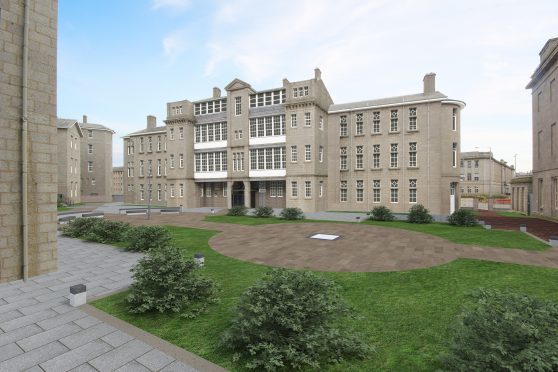Plans to rejuvenate the site of a historic Aberdeen hospital have taken a step forward.
A full planning application has been lodged with Aberdeen City Council for the site of the former Woolmanhill Hospital,
The plans include a 52-bedroom boutique hotel, 27 services suites, 30 residential apartments and 10 affordable homes, with a traffic-free central square at the heart of the development.
The plans to renovate four of the A-listed buildings have been jointly submitted by developer Charlie Ferrari’s company CAF Properties (Woolmanhill) Ltd and NHS Grampian, who are the current owners of the site.
Woolmanhill was the location of the original Aberdeen Royal Infirmary and an operational hospital has been on the site since it opened in 1749.
The Royal Infirmary was rebuilt between 1833 and 1840, in the Grecian style, while the Simpson Pavilion, designed by Aberdeen architect Archibald Simpson, is one of the last surviving examples of a pre-Nightingale style of hospital design.
Health chiefs opted to close the hospital in 1999 and services have slowly been moved since, with only audiology and nose and throat units remaining.
Mr Ferrari believes the development will complement existing architecture in the area.
He said: “We believe our proposal will make a significant contribution to the wider masterplan for the revitalisation of Aberdeen city centre.
“Woolmanhill is an important landmark in Aberdeen and breathing new life into this site preserves its history and marks a new chapter in its story for current and future generations.”
Under the plans, the Simpson Pavilion would become the hotel.
The east-facing Stephen Building, which looks out on to the Woolmanhill roundabout, will be home to 27 one, two and three-bedroom serviced suites.
The Victoria Building will be renovated and converted into 30, two and three-bedroom apartments and the smallest building on the site – the Archive building – will become 10 affordable flats.
It is hoped the hotel will provide a venue for weddings and conferences with parking provided both on-site and at the adjacent NCP car park.
The hotel and serviced apartments would be owned and operated by the Glasgow-based G1 Group (Holdings) Plc.
It is hoped redevelopment work could start next year, with the project set for completion by mid-to-late 2019.
